The Razer Blade Stealth Review: Razer Takes On The Ultrabook
by Brett Howse on March 29, 2016 8:00 AM EST- Posted in
- Laptops
- Razer
- Skylake
- Razer Blade Stealth
- eGFX
- Razer Core
- Skylake-U
System Performance
When you buy a Razer Blade Stealth, you get just a single CPU option in the Intel Core i7-6500U processor. This is a dual-core chip with hyperthreading, and it has a base frequency of 2.5 GHz with a turbo frequency of 3.1 GHz. On the CPU side, it’s the second fastest offering in the standard "2+2" 15W Skylake-U series, with only the i7-6600U above it . This 15-Watt processor has Intel’s HD 520 graphics, with 24 execution units and a maximum frequency of 1.05 GHz. With Razer’s gaming heritage, it would have been nice to see the new "2+3e" Iris parts with eDRAM, but likely due to the target price this wasn’t an option. Meanwhile the 8 GB of RAM is DDR3-1866 in a dual-channel configuration.
The model tested is the Core i7-6500U with 8 GB of memory, 512 GB of storage, and the UHD display.
To test the system performance, the Stealth has been put through our standard notebook workload. The Stealth has been put up against several other Ultrabooks to see where it fits in performance wise, but if you want to compare it to any other device we’ve tested, please check out our Notebook Bench.
PCMark
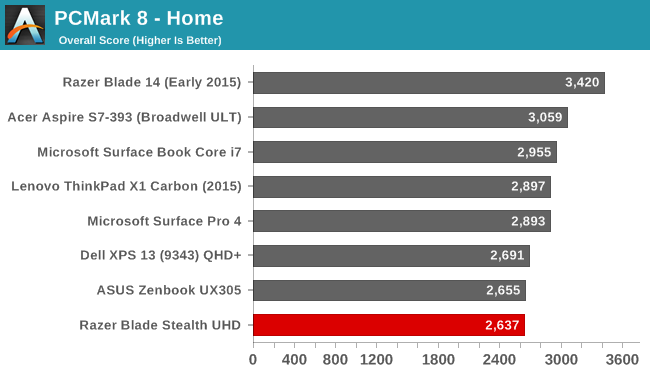
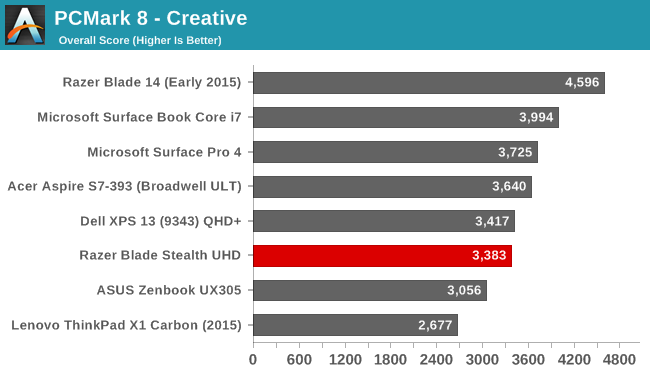
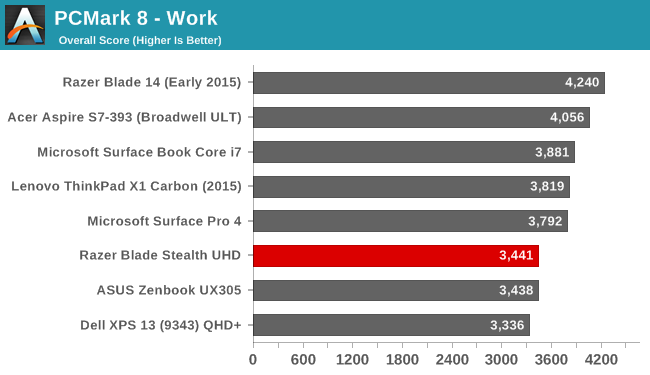
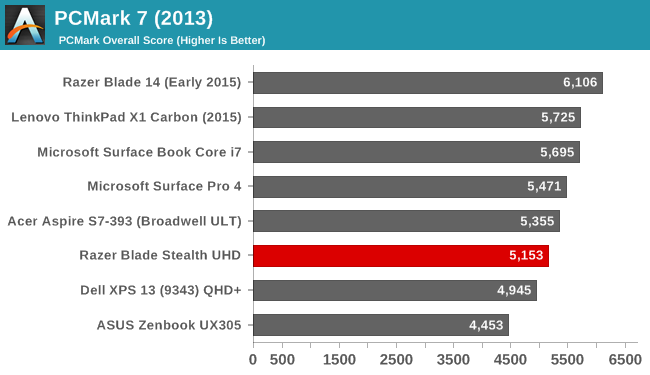
PCMark attempts to simulate real-life workloads with several sets of tests. The workload tests all aspects of the device, and factors like the display resolution can come into play here on the gaming tests. Storage has its own set of tests which recently changed, so the new results are not comparable to the old ones. The workload is varied, and the Stealth falls in-line with other similar devices, although the high resolution display certainly pulls the scores down a bit compared to the competition.
Cinebench
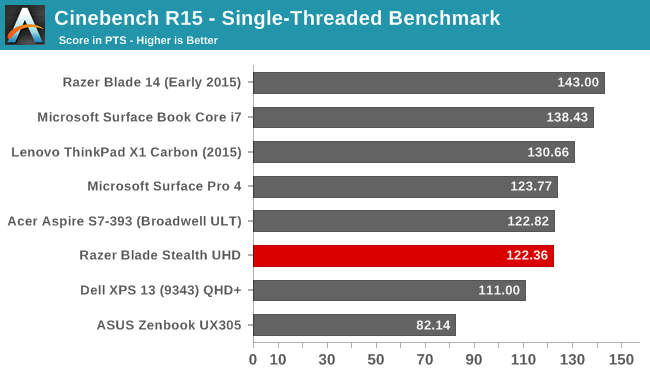
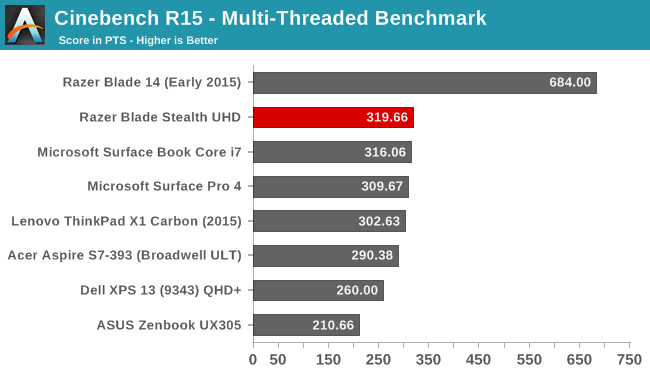
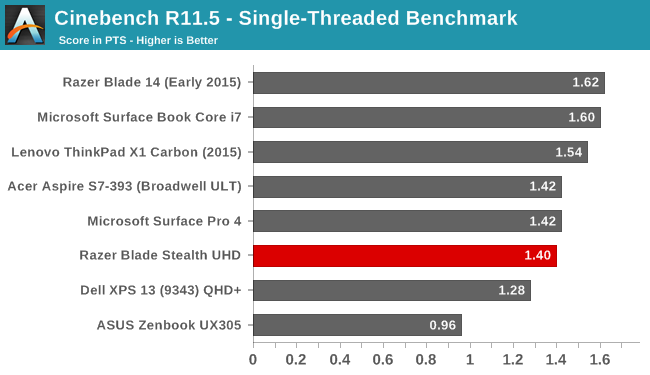
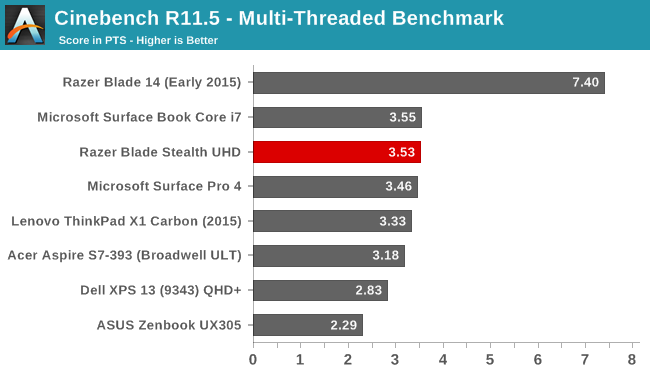
Cinebench is a rendering program, with single-thread, multi-thread, and OpenGL tests. For notebooks, we focus on the single and multi-threaded tests, and this is a good indication of CPU performance. The i7-6500U does especially well in the multi-threaded portion.
x264
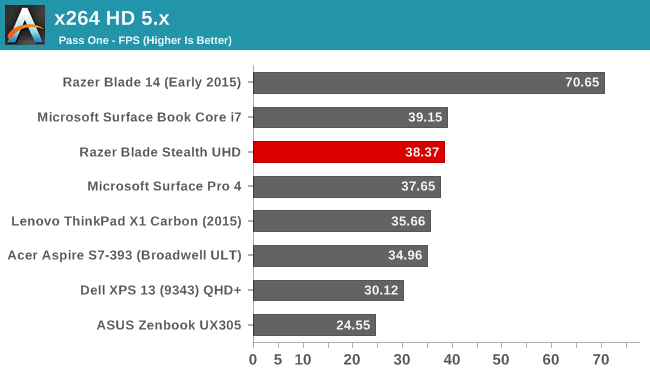
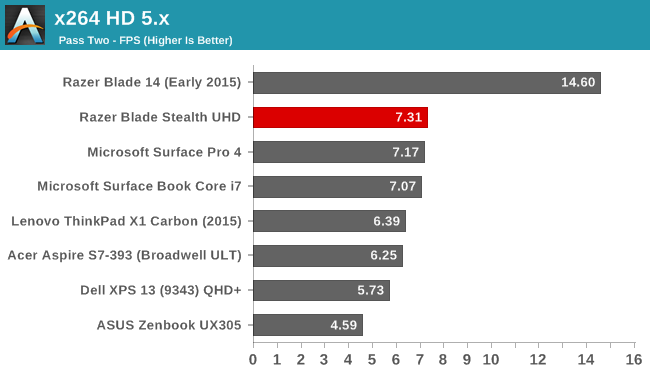
This test converts a 1080p video into the x264 format, and like Cinebench, it prefers high CPU frequencies and more cores. The Core i7 does very well in this test relative to other Ultrabooks.
Web Tests
Web browsing is still one of the most common tasks anyone does on a PC, so strong performance here is always a benefit. The scores below will be either done with Google Chrome as the browser if the machine was running Windows 8.1, or Microsoft Edge if the device was running Windows 10.
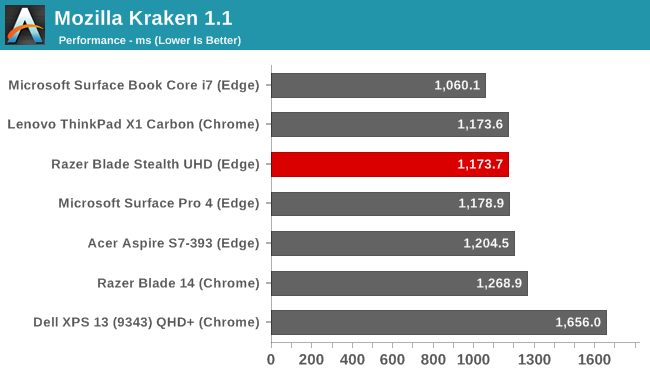
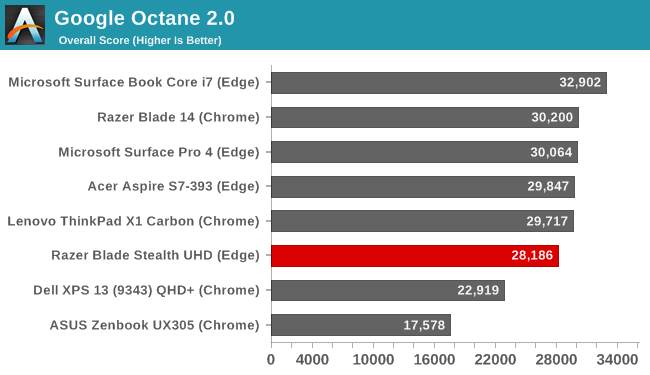
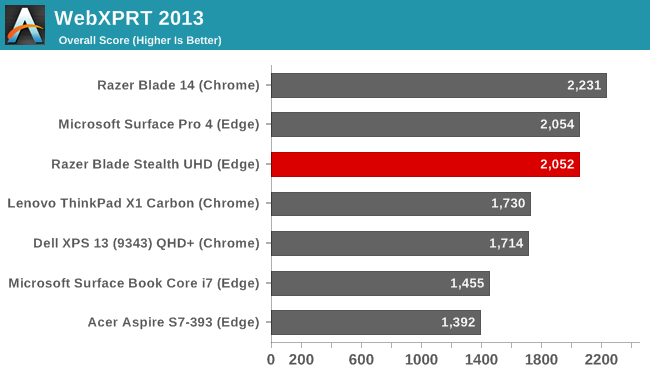
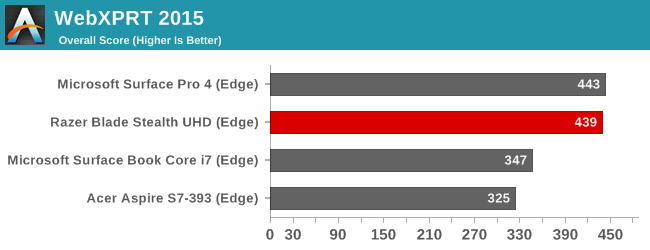
While not quite as fast as the Microsoft Surface Book, the Razer Blade Stealth still does very will in these tests.










66 Comments
View All Comments
ImSpartacus - Tuesday, March 29, 2016 - link
The battery life is disappointing, but at least seems to be alright otherwise.The keyboard appears like overkill, but at least you can presumably switch to a clean white light.
Keao - Tuesday, March 29, 2016 - link
It is overkill if you just want an ordinary ultrabook indeed. Needs to see if the glowing razer logo on the back can be deactivated too. (You can switch to plain white for sure given it works like the blackwidow chroma that I have)Battery life is really not great but is OK for the kind of processor they have isn't it? What's putting me a lil' off is the fact that to make it a gaming machine you do need to shell out at least some 750 additional bucks. Sure the external case will be re-used supposedly but I'm unsure about the future of this solution (Can evolve quite fast with a new Thunderbolt version and/or replacement of the PCI-e interface?)
zeroqw - Tuesday, March 29, 2016 - link
"Battery life is really not great but is OK for the kind of processor they have isn't it?" nope.. there are quite similar ultrabooks with at least 50% more battery life.Razer put a small battery in the laptop and if you add the backlit keyboard+glowing razer logo to the equation it just makes it even worse. Too bad because I love the design but the battery life is a deal breaker for me.
Duraz0rz - Tuesday, March 29, 2016 - link
You can turn off the logo LED thru Synapse.TheinsanegamerN - Tuesday, March 29, 2016 - link
Wont fix the battery being too small.DanNeely - Tuesday, March 29, 2016 - link
The battery size isn't the main problem; it's in the same general class as other 13" ultrabooks. The problem is that the laptop's efficiency is bad; if they were able to match their competitions efficiency they'd pick up an extra hour or two bringing the QHD model up to the average for a laptop of its size; and leaving the 4k one with only the penalty related to its ultra high res display (both more GPU work to drive it, and more transistors in the panel blocking a larger amount of the backlight).ImSpartacus - Tuesday, March 29, 2016 - link
I think Razer is struggling with both the pixel race and needing to justify the existence of Core.Honestly, a 768p display would be perfect for a 12.5" laptop (maybe 900p for a buy-up). But then you could say that Razer should've made the Core a smidge thicker and put a modest dGPU in there for gaming.
Spunjji - Wednesday, March 30, 2016 - link
Couldn't disagree more about the display. The sooner we get rid of low-DPI panels and the software ecosystem is forced to accept their existence, the better. The problem here isn't the display, it's a lack of engineering experience regarding power efficiency at Razer.BrokenCrayons - Wednesday, March 30, 2016 - link
I disagree with that. Higher resolution displays, while nice looking, offer little to no added functionality after reaching the point where it becomes necessary to scale the interface in order to retain visibility of objects displayed in it. At this point, they're part of the specifications for the sake of specifications war that's vital for product differentiation and marketing, but that's where it ends. Sacrificing capability as in the case of battery life to achieve a pointlessly high resolution shows particularly poor engineering. An Intel GPU in a 12.5 inch laptop display that is unable to drive games at much lower resolutions should be paired with a 1366x768 panel of decent quality with good viewing angles. Anything more than that won't benefit the end user regardless of how much they think they need more pixels.JoeyJoJo123 - Wednesday, March 30, 2016 - link
>should be paired with a 1366x768 panel of decent quality with good viewing angles.Except that's the thing. In the year 2016 there is no such thing as a 1366x768 panel of anything remotely decent quality. Panels of this size are just churned out by the factory for extremely low cost/low margin devices such as $300 laptops at Walmart.
If you're paying ~$1500 for a premium laptop, you should expect an arguably premium display. If you can't play the game at 2560x1440, then run the game at reduced settings, and if that's not enough, begin lowering the resolution, too.
Paying ~$1500 for a premium laptop also comes with the inherent notion you're paying for premium battery life, but you're not getting that here, either.
Replacing a good screen on a laptop with a bad battery leaves you with a laptop with bad screen and bad battery and now you have an even worse value proposition than before.